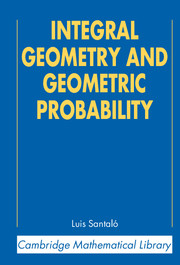Introduction
Convex sets play an important role in integral geometry. For this reason we will review here their principal properties, especially those which will be needed in the following sections. In this chapter we consider convex sets in the plane. For convex sets in n-dimensional euclidean space, see Chapter 13. For a more complete treatment, refer to the classical books of Blaschke [50] and Bonnesen and Fenchel [63], or to the more modern texts of Benson [27], Eggleston [162], Grünbaum [247], Jaglom and Boltjanski [320], Hadwiger [270], Hadwiger and coauthors [282], and Valentine [683].
A set of points K in the plane is called convex if for each pair of points A ∈ K, B ∈ K it is true that AB ⊂K, where AB is the line segment joining A and B. For convenience we shall assume throughout that the convex sets are bounded and closed.
A curve with end points P, Q, is called convex if its point set, together with the segment PQ, bounds a convex set. If the convex set K is bounded and has interior points, then the boundary of K is called a closed convex curve. Throughout, we will denote by ∂K the boundary of the set K. If all the points of K belong to ∂K, then K is a line segment.
We can prove that (a) All convex curves are piecewise differentiable (i.e., they are the union of a countable set of arcs with continuously turning tangent); in other words, convex curves have at most a countable set of corners; (b) All bounded convex curves are rectifiable.

